Textiles and Dress Designing - Laying The Patterns | 12th Textiles and Dress Designing : Chapter 8 : Laying the Pattern, Marking and Cutting
Chapter: 12th Textiles and Dress Designing : Chapter 8 : Laying the Pattern, Marking and Cutting
Laying The Patterns
Laying The Patterns
A fabric has to be prepared well it should be pre-shrunk and ironed
before the patterns are placed on it. The fabric has to be spread neatly on a
clean large table. One can even use a clean floor. Remember to use a surface
bigger than fabric, so that overlapping of the fabric or mismarking can be
avoided.
Different Types of Layout
Layout has to follow a specific pattern, which mainly depends upon
the type of the garment, the pattern pieces and the width of
the fabric. The different types of fabric layout namely lengthwise centre fold,
off centre lengthwise fold, cross wise centre fold, off centre cross wise fold,
combination fold and open layout.
Pattern Laying of Special Fabric
Pattern laying need extra care when the fabric vary like knits or
silk.
Knits
The inter looping of a single yarn is known as knitted fabric. There
are various varieties of knitted fabrics like single and double jersey, tricot
and rib. Jersey fabrics are mostly used for garment construction.
·
Pulling or tearing should be avoided to straighten the fabric.
·
Lay the folded edges straight on a flat surface or cutting table.
·
Fold the fabric at right angles and cut from selvedge.
·
Mark the outline of the patterns using a tailor’s chalk or red and
blue pencil.
·
Open layout is best for jersey fabrics irrespective of the type of
the garment.
Silk
These fabrics are very thin, slippery and delicate. Great care is
required in marking and cutting these fabrics. Pre shrinking is not required
for silk fabrics. They can be used directly as purchased from the shops.
To straighten the fabric, lay them on the table and pull in cross
wise direction. Lay the fabric on the flat smooth surface. Move fingers
smoothly over the fabric to remove creases.
Place the pattern on the right side of the fabric. Right side can
be identified by seeing and feeling. The right side of the fabric is always
brighter and smoother. Open layout is best suited this type of fabric
especially for beginners.
2. Pattern Laying Based on Designs
Design incorporated in a fabric should be emphasized to enhance
the personalities of the wearer. Hence pattern should be laid carefully to
maintain the designs and to harmonize it with the basic silhouette.
Bold designs
A large motif can be used for all type of garments, but they look
best when they placed in irregular fashion.
If a fabric has too many motifs arranged in a crowded manner or a
irregular pattern, they can be placed next to each other, cut and sewn.
When the material has been well designed with selvedge, large
motif is repeated at equal distance, place these design onto the centre of the
pattern. Do not cut through large motifs because it is difficult to match seam
lines.
Pattern laying techniques vary based upon the design also.
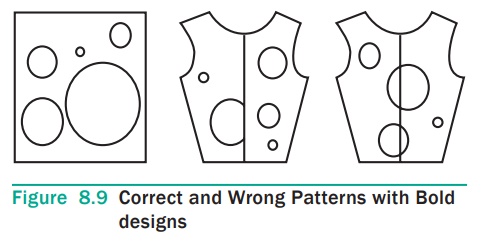
One-Way Designs
One-way designs can be printed or woven in nature. Design goes in
one direction. Example: Flowers on a creeper can be woven from selvedge to
selvedge in the lengthwise direction or a group of geometrical designs can be
printed.
When patterns are laid on these types of fabric one must carefully
check if the seam lines on one pattern match with the design of the pattern
which is joined.
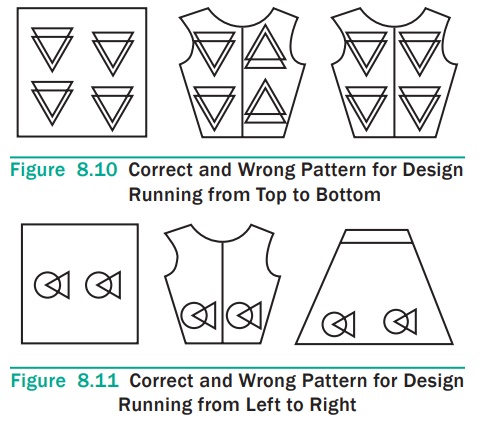
Stripes and Plaids
Stripes are straight line running in lengthwise or crosswise
direction. These stripes are called vertical stripes and horizontal stripes.
Stripes are most commonly used in shirt patterns. They can be cut
in lengthwise and crosswise direction to create zigzag effects on garments.
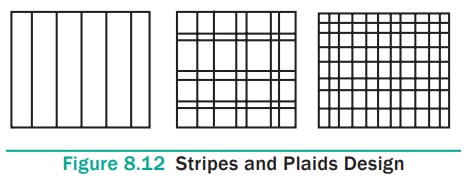
Collar, sleeves, Pocket patterns can be cut in cross grain on
vertical striped material to create interest to the garment. Stripes and plaids
can be even or balanced and uneven or unbalanced.
Even balanced stripes can be described as lines or bar arranged in
a definite colour or placement.
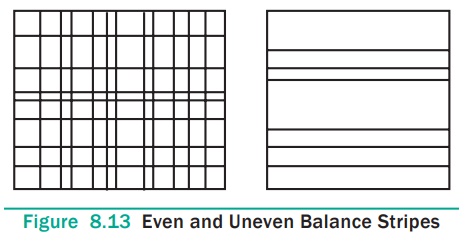
Border Designs
❍❍ These designs run along
one selvedge only, they can be woven or printed.
❍❍ These designs can be
used along the hem lines of the bodice, skirt and sleeve patterns.
❍❍ In order to maintain
the design line some patterns like yokes and collars cut on straight grain.
This fabric cannot be used for curved edged garments like flared skirts.
❍❍ One must make sure that
the hem lines are straight to follow this design. While placing pattern on
these designed fabrics, one must take care to match the designs.
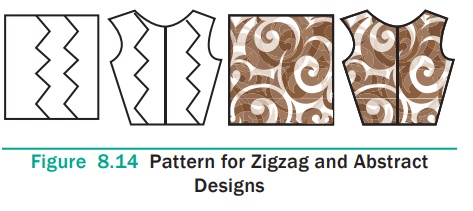
Related Topics